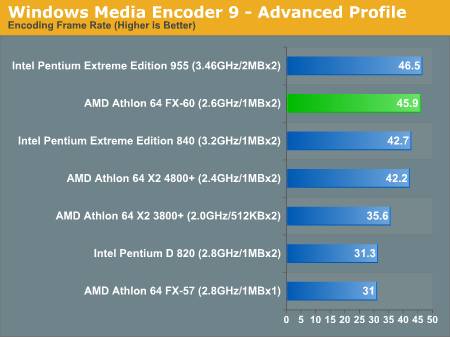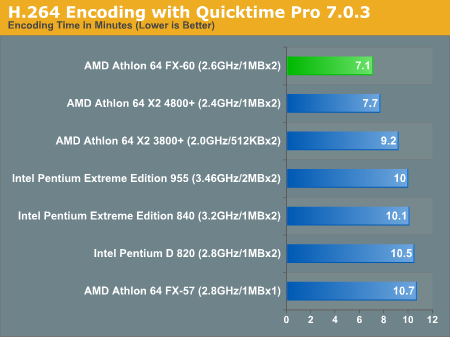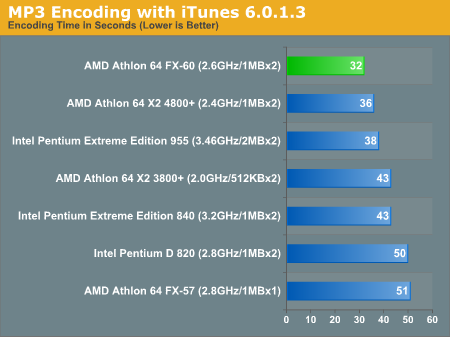AMD Athlon 64 FX-60: A Dual-Core farewell to Socket-939
by Anand Lal Shimpi on January 9, 2006 11:59 PM EST- Posted in
- CPUs
Media Encoding Performance using DVD Shrink, WME9, Quicktime and iTunes
First up is DVD Shrink 3.2.0.15. Our test was simple - we took a copy of Star Wars Episode VI and ripped the full DVD to the hard drive without compression, effectively giving us an exact copy of the disc on the hard drive. Then, using the copy of the DVD on the hard drive (to eliminate any DVD drive bottlenecks), we performed a DVD shrink operation to shrink the movie to fit on a single 4.5GB DVD disc. All of the options were left on their defaults, so the test ends up being pretty easy to run and reproduce. The scores reported are DVD encoding times in minutes, with lower numbers meaning better performance.
The DVD Shrink test is quite important as DVD Shrink is quite possibly one of the easiest tools to rip a DVD. The easier a tool is to use, the more likely it's going to be used, and arguably the more important performance using it happens to be.
Moving on, we have our Windows Media Encoder 9 test, which uses the advanced profile settings for video encoding. We left all settings at their defaults and just proceeded with a MPEG-2 to WMV-HD conversion. The values reported are in frames per second, with higher numbers being better.
Next up, we have Quicktime Pro 7.0.3 and we perform a MPEG-2 to H.264 encoding task. All of the settings are left at their defaults, with the exception that we optimize the output file for download with a 256kbps data rate while leaving the resolution untouched. We also adjust the video options to optimize for the best quality. We report the transcoding time in minutes, with lower values being better.
Finally, we have a MP3 encoding test using iTunes 6.0.1.3. For this test, we simply took a 304MB wav file and converted it to a 192kbps MP3 file, measuring the encode time in seconds. The only iTunes option that we changed was to prevent the playback of the song while encoding.
First up is DVD Shrink 3.2.0.15. Our test was simple - we took a copy of Star Wars Episode VI and ripped the full DVD to the hard drive without compression, effectively giving us an exact copy of the disc on the hard drive. Then, using the copy of the DVD on the hard drive (to eliminate any DVD drive bottlenecks), we performed a DVD shrink operation to shrink the movie to fit on a single 4.5GB DVD disc. All of the options were left on their defaults, so the test ends up being pretty easy to run and reproduce. The scores reported are DVD encoding times in minutes, with lower numbers meaning better performance.
The DVD Shrink test is quite important as DVD Shrink is quite possibly one of the easiest tools to rip a DVD. The easier a tool is to use, the more likely it's going to be used, and arguably the more important performance using it happens to be.

Moving on, we have our Windows Media Encoder 9 test, which uses the advanced profile settings for video encoding. We left all settings at their defaults and just proceeded with a MPEG-2 to WMV-HD conversion. The values reported are in frames per second, with higher numbers being better.

Next up, we have Quicktime Pro 7.0.3 and we perform a MPEG-2 to H.264 encoding task. All of the settings are left at their defaults, with the exception that we optimize the output file for download with a 256kbps data rate while leaving the resolution untouched. We also adjust the video options to optimize for the best quality. We report the transcoding time in minutes, with lower values being better.

Finally, we have a MP3 encoding test using iTunes 6.0.1.3. For this test, we simply took a 304MB wav file and converted it to a 192kbps MP3 file, measuring the encode time in seconds. The only iTunes option that we changed was to prevent the playback of the song while encoding.

3D Rendering Performance using 3dsmax 7
Gaming Performance using Battlefield 2, Call of Duty 2 and Quake 4










94 Comments
View All Comments
Betwon - Tuesday, January 10, 2006 - link
Edit:Ratio is 1.27 only.
Betwon - Tuesday, January 10, 2006 - link
NO.It is not 939-pin 175.
The most important:
It is the FP performance/64-bit and Linux OS.
Few people use Linux OS.
PD820 -- the FP performance of windows/32bit
Betwon - Tuesday, January 10, 2006 - link
P4 better than X2.Ratio is the key.
The ratio below 1.33 -- P4 is behide.
ratio above 1.4x -- P4 is competitive. Intel 4.26GHz VS AMD 2.9GHz
For the ratio of intel 820 VS AMD 3800+ 165 170? see the benchmark of spec cpu2000 rates for 2 core 1 chip:
The float point performance(under windows OS/32-bit):
PD 820 SPECfp_rate_base2000 29.9 SPECfp_rate2000 30.0
http://www.spec.org/osg/cpu2000/results/res2005q4/...">http://www.spec.org/osg/cpu2000/results/res2005q4/...
170(939-pin 2GHz 1MX2) SPECfp_rate_base2000 25.2 SPECfp_rate2000 26.3
http://www.spec.org/osg/cpu2000/results/res2005q4/...">http://www.spec.org/osg/cpu2000/results/res2005q4/...
We don't find the benchmark of 165 and 3800+, but we find the benchmark of 175.
170(939-pin 2.2GHz 1MX2) SPECfp_rate_base2000 26.2 SPECfp_rate2000 27.3
http://www.spec.org/osg/cpu2000/results/res2005q3/...">http://www.spec.org/osg/cpu2000/results/res2005q3/...
We don't find the benchmark of both PD and X2/opteron dc under windows OS/64bit, so we can not compare the dual-core float point performance 64-bit directly.
The test--SPECfp_rate is the most important test for CPU float performance. AMD approbate SPECfp_rate for testing dual-core's FP performance.AMD think it is a fair test.
flyck - Tuesday, January 10, 2006 - link
in my opinion spec scores arent that meaningfull. for example look @ the scores of a P-M and then in real applications.It is great for giving a fast overall impression but hardly something to base your overall descission on.
but i do agree with your ratio you wrote down now.(if you discount ram overclock and others)
1.33 p4 is slower
1.4x p4 is competive
>1.55 p4 is faster
But in this case : you can overclock that p4 very well but say you overclock them both max with prom or other good cooling devices. you'll have 3-3.3GHz compared to 4.5-5Ghz p4. and i think those are pretty competive against eachother. But still that doesn't convince me in buying that p4. ok it overclocks better but in the end the difference is nothing.
Betwon - Tuesday, January 10, 2006 - link
AMD think spec cpu2000 rates for testing multi-core is very very important.And lots of professional and smart person who really know cpu's tech think it is the best benchmark for testing FP/Int performance.
If you look at some professional articles about how to improve the CPU's performance ac about , you will find that spec cpu is the most important and most frequently used for the standard of performance benchmark.
flyck - Tuesday, January 10, 2006 - link
that doesn't mean it is not a benchmark with its flaws. and if you look @ those scores there are many fluctuations depending on the cpu.don't get me wrong, spec is nice to measure performance but has his major flaws to test overall performance or the performance the cpu really will get.
Betwon - Tuesday, January 10, 2006 - link
spec don't measure video card's performance. But it measures the performance of cpu, memory and so on.So, it is the most important performance test, and show the performance the cpu really get.
If you find another more important performance test which can measure the FP/INT performance, please tell us.
But you can not find it. We can not find it too.
fluctuations?
275 is different with 939-pin 175, and it's benchmark is under 64-bit(275) but not under 32-bit(175).
Betwon - Tuesday, January 10, 2006 - link
No. you don't how to understand the tests.Yes, X2 win the games, but X2 lose in many tests.(I think that (for games) the ratio need at least 1.5 or more)
Let's look at the ratio 1.46(4.26/2.9)
PCMark05 test for CPU
955 7431
FX-60 5912
DiVX6.1
955 354sec
FX-60 388sec
XviD1.1
955 364sec
FX-60 380sec
CS2
955 98sec
FX-60 107sec
Premiere Pro 1.5
955 163sec
FX-60 178sec
FineReader8.0
955 140sec
FX-60 160sec
3D rendering
3ds max7.0 CPU Render
955 3.46
FX-60 3.19
Maya7.0
955 40.9sec
FX-60 41.96sec
Only one?
The more accurate ratio will be ?
Without OC, for most poeple , they will not buy X2@2.4G or X2@2.6G or PD@3.2G or PD 3.46G, they may buy PD820/920 or X2@1.8G or 2.0G(such as 3800+ ,165, 170).
We can get the more accurate ratio from spec cpu2000 rates for dual-core.
Note: spec cpu2000 rates is admit by AMD.
For integer performance,
flyck - Tuesday, January 10, 2006 - link
pcmark05 :roll: overall it is equal between the two.DIVX6.1 p4 8% faster
XVID p4 4% faster
mp3 ecoding same time
WME : FX 25% faster
photoshop : p4 8% faster
3dsmax interactive : FX 12% faster
cpu rendering : p4 8% faster
Maya : equal
far cry : FX 16% faster
half life: FX 17% faster
this is hardly called a victory for p4 ... i would even say overall FX is faster.
Betwon - Tuesday, January 10, 2006 - link
No. you don't know how to understand the tests.pcmark05 overall? NO, it will include video card/harddisk benchmark.
Now let's the benchmark of CPU:
PCMark05 test for CPU
955 7431
FX-60 5912
Intel faster 25.7%
About encoding
DiVX6.1
955 354sec
FX-60 388sec
Intel faster 9.6%
XviD1.1
955 364sec
FX-60 380sec
Intel faster 4.4%
CS2
955 98sec
FX-60 107sec
Intel faster 9.2%
Premiere Pro 1.5
955 163sec
FX-60 178sec
Intel faster 9.2%
FineReader8.0
955 140sec
FX-60 160sec
Intel faster 14.3%
3D rendering
3ds max7.0 CPU Render
955 3.46
FX-60 3.19
Intel faster 8.5%
Maya7.0
955 40.9sec
FX-60 41.96sec
Intel faster 2.6%
Except the games, this is hardly called a victory for X2 ... i would even say overall P4 is faster.
Note: Now , the ratio is 1.46 -- 4.266GHz/2.926GHz